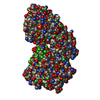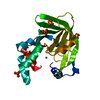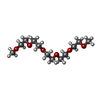+Search query
-Structure paper
| Title | The Salmonella enterica ZinT structure, zinc affinity and interaction with the high-affinity uptake protein ZnuA provide insight into the management of periplasmic zinc. |
|---|---|
| Journal, issue, pages | Biochim Biophys Acta, Vol. 1840, Issue 1, Page 535-544, Year 2014 |
| Publish date | Oct 12, 2013 |
 Authors Authors | Andrea Ilari / Flaminia Alaleona / Giancarlo Tria / Patrizia Petrarca / Andrea Battistoni / Carlotta Zamparelli / Daniela Verzili / Mattia Falconi / Emilia Chiancone /  |
| PubMed Abstract | BACKGROUND: In Gram-negative bacteria the ZnuABC transporter ensures adequate zinc import in Zn(II)-poor environments, like those encountered by pathogens within the infected host. Recently, the ...BACKGROUND: In Gram-negative bacteria the ZnuABC transporter ensures adequate zinc import in Zn(II)-poor environments, like those encountered by pathogens within the infected host. Recently, the metal-binding protein ZinT was suggested to operate as an accessory component of ZnuABC in periplasmic zinc recruitment. Since ZinT is known to form a ZinT-ZnuA complex in the presence of Zn(II) it was proposed to transfer Zn(II) to ZnuA. The present work was undertaken to test this claim. METHODS: ZinT and its structural relationship with ZnuA have been characterized by multiple biophysical techniques (X-ray crystallography, SAXS, analytical ultracentrifugation, fluorescence spectroscopy). RESULTS: The metal-free and metal-bound crystal structures of Salmonella enterica ZinT show one Zn(II) binding site and limited structural changes upon metal removal. Spectroscopic titrations with Zn(II) yield a KD value of 22±2nM for ZinT, while those with ZnuA point to one high affinity (KD<20nM) and one low affinity Zn(II) binding site (KD in the micromolar range). Sedimentation velocity experiments established that Zn(II)-bound ZinT interacts with ZnuA, whereas apo-ZinT does not. The model of the ZinT-ZnuA complex derived from small angle X-ray scattering experiments points to a disposition that favors metal transfer as the metal binding cavities of the two proteins face each other. CONCLUSIONS: ZinT acts as a Zn(II)-buffering protein that delivers Zn(II) to ZnuA. GENERAL SIGNIFICANCE: Knowledge of the ZinT-ZnuA relationship is crucial for understanding bacterial Zn(II) uptake. |
 External links External links |  Biochim Biophys Acta / Biochim Biophys Acta /  PubMed:24128931 PubMed:24128931 |
| Methods | SAS (X-ray synchrotron) / X-ray diffraction |
| Resolution | 2 - 2.52 Å |
| Structure data |  SASDA35:  PDB-4arh:  PDB-4aw8:  PDB-4ayh: |
| Chemicals |  ChemComp-SO4:  ChemComp-HOH:  ChemComp-ZN:  ChemComp-PG6:  ChemComp-NA: |
| Source |
|
 Keywords Keywords | METAL BINDING PROTEIN / PERIPLASMIC PROTEIN / ZINC TRANSPORT / METAL-BINDING PROTEIN |
 Movie
Movie Controller
Controller Structure viewers
Structure viewers About Yorodumi Papers
About Yorodumi Papers



 Salmonella enterica subsp. enterica serovar nchanga (bacteria)
Salmonella enterica subsp. enterica serovar nchanga (bacteria)